Section 2 What Japan's ODA Achieved in 60 Years
As was outlined thus far, over the past 60 years since Japan's reconstruction period shortly after WWII, Japan consistently assisted developing countries through ODA. At all times, Japan extended a helping hand to people suffering from poverty and disease as well as to people in the world who could not have hope for tomorrow. This goes back to the original purpose of Japan's provision of ODA and gets to the root of what the country of Japan stands for. Above all, as one of the leading responsible members of the international community, Japan today has an inherent obligation to make contributions commensurate with its national power for tackling extreme poverty, global challenges, and issues such as peacebuilding. Also, Japan must meet the expectations that the international community places on Japan which has become a major power. There is a Japanese expression “on-okuri” which dates back to ancient times. The term refers to repaying a good deed one has received by doing good not directly to the original benefactor but to others. The idea is that in doing so, good deed will spread throughout society, and in turn, all of society will benefit. After WWII, Japan received generous deeds from the world in the form of assistance. Now, Japan is in a position of doing good deeds to developing countries.
Another highlight of ODA is that it creates an international environment that is necessary for the peace, stability, and prosperity of Japan while deepening Japan's relations with other countries, including Asian countries. This is essential, so long as Japan's assistance uses taxpayers' money amid a severe financial situation. If Japan postpones addressing the issues that are mounting across the world, this could, for example, lead to poor countries becoming hotbeds of terrorism or to the further deterioration of the global environment. This in turn could place a considerable burden on future generations. These issues are not somebody else's problems; dealing with them is also vital for Japan. ODA for developing countries not only benefits the recipient countries and the whole international community but also contributes to the peace, stability, and prosperity of Japan.
1. The Characteristics and Achievements of Japan's ODA
As shown in the previous section, throughout the past 60 years, Japan's ODA for developing countries has been provided based on the consistent concept of: (1) supporting the self-help efforts of developing countries; (2) prioritizing sustainable economic growth through the development of economic and social foundations, human resources development, and institutional development; and (3) cooperation from the perspective of human security. Japan's ODA which was extended from each of these perspectives and what this ODA achieved will be described with concrete examples.
(1) Supporting Self-Help Efforts
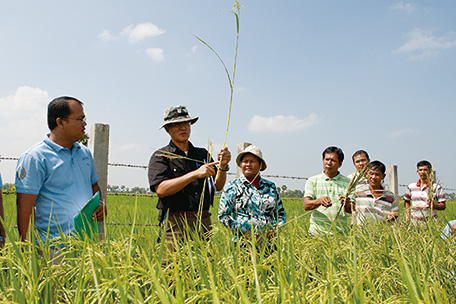
An expert, Mr. Satoru Hagiwara, giving guidance in a muddy rice field to help improve agricultural techniques and develop irrigation facility, which will contribute to increase the income of farmers in Cambodia. (Photo: Shinichi Kuno / JICA)
The first characteristic – proactively supporting the self-help efforts of developing countries – is a concept Japan has underscored even before the Western countries, and is premised on Japan's history, experience with postwar reconstruction, and experience of extending assistance to the Asian region. The concept is based on the idea that a country's development based on self-help efforts facilitates the self-reliant economy of that country and that ODA is no more than a tool to this end. While the international community now recognizes the importance of self-help efforts and “ownership,” Japan has given priority to them since the launch of its ODA. In the TICAD process that Japan started in 1993, Japan has been advocating constantly the principles of “ownership” and “partnership” from TICAD's commencement.
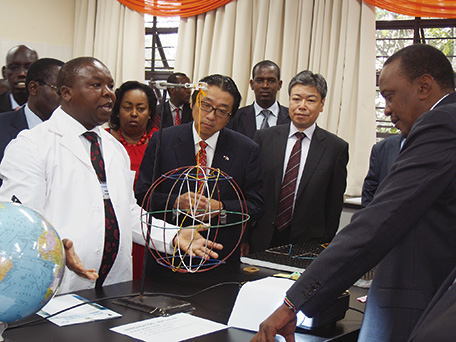
Kenyan President Uhuru Kenyatta (far right) watching an experiment at the Centre for Mathematics, Science and Technology Education in Africa (CEMASTEA) in Kenya (Photo: JICA)
Japan's approach of supporting the self-efforts of developing countries is seen in Japan's technical cooperation that emphasizes human resources development in developing countries. Many developing countries laud the tradition of Japan's ODA of taking time to develop human resources, thinking together with the recipient country on its development process, and moving forward together. Typical examples that vividly illustrate ODA's achievements are presented below.
One example is a technical cooperation project that commenced in Kenya and was scaled up to the whole African continent. It is called the Strengthening of Mathematics and Science Education (SMASE) project. SMASE is the first basic education support project that Japan's ODA implemented in Africa in 1998. Improving mathematics and science education was a pressing issue in Kenya at the time in its quest for industrialization. Specifically, enhancing the capabilities of mathematics and science teachers was an urgent issue. At Kenya's request, Japan dispatched Japanese cooperation experts through ODA and established institutionalized training opportunities for teachers of secondary schools (a Kenyan secondary school is equivalent to Japan's third year of junior high school to the third year of high school). At the same time, classes that encouraged the proactive participation of students were offered using locally procurable experiment equipment. This effort, which was tailored to the situation in Kenya, proved to be fruitful. The teachers' teaching methods changed, and students became more interested in and had a better understanding of these subjects. Students' academic performance also improved. This training project was subsequently scaled up to the national level. Over a period of 15 years up to 2013, 70,000 mathematics and science teachers and 15,000 principals of secondary schools participated in the trainings, along with 180,000 teachers and 7,000 principals and vice-principals of primary schools.
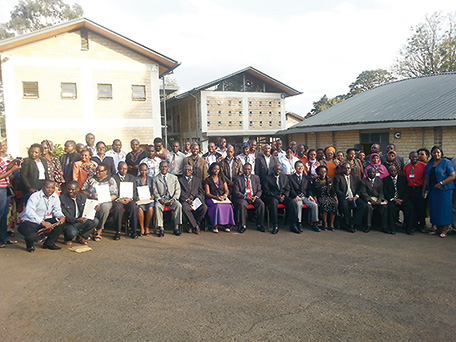
Commemorative photograph at the closing ceremony of the third country training for mathematics and science education in Africa. Many participants attended from African countries around Kenya. (Photo: JICA)
SMASE activities are not confined to Kenya. In 2001, Japan launched the Strengthening of Mathematics and Science Education in Western, Eastern, Central and Southern Africa (SMASE-WECSA) project to scale up the activities to other African countries facing similar challenges. At present, mathematics and science education technical cooperation which draws on the experience in Kenya is or will be implemented in 14 African countries. Since 2004, the Kenyan government has carried out third-country trainings(Note 9) in Kenya in cooperation with Japan. Through March 2014, 1,749 people in the education field from 30 African countries participated in the trainings. Kenyan teachers who were previously training recipients are now giving guidance to their colleagues in other African countries.
In March 2014, Kenya's President Uhuru Kenyatta attended an inauguration ceremony following the completion of the upgrading and refurbishment of the Centre for Mathematics, Science and Technology Education in Africa (CEMASTEA) in Kenya's capital city of Nairobi. CEMASTEA is the major base for training teachers and serves as a training center for mathematics and science teachers that SMASE produced in Africa. As a result of the upgrading and refurbishment, CEMASTEA can host 200 participants in one sitting as opposed to the previous 92 participants. With Japan as its partner, Kenya will continue to contribute to mathematics and science education in Africa.
The second example is also from Africa. At the strong initiative of the Government of Tanzania in East Africa, the Local Government Reform Program has been implemented from 2000 that promotes decentralization by devolving the powers, budget, and personnel of the central government to the districts. However, reform is not easy, and Tanzania requested Japan's assistance for advancing the reforms.
Following the Meiji Restoration, Japan built up an administrative system that was suited to Japan through a process of successive public debates and trials and errors, while learning from Western systems. After WWII, while pursuing economic development, Japan began developing the capacities of local governments and took some time to carry out full-fledged decentralization. While reforms proceeded at a slow pace, Japan has experience with steady reforms. Believing that this experience would be useful for Tanzania, Japan provided the following five supports.
The first was a training program that invited to Japan Tanzanian leaders engaged in local government and decentralization reforms in order to increase their awareness of the issues.
The second was assistance for creating a training framework aimed at the capacity development of local government officials and for local governments to be able to conduct such trainings. The decentralized powers and budget need to be utilized to ensure that decentralization leads to improvements in the lives of the people.
Thirdly, to be able to deliver services despite the limited personnel and budgets of local governments, Japan extended assistance for fostering leaders called “facilitators” who encourage the self-help efforts of the people and who facilitate collaboration between the government and the people (equivalent to the Seikatsu Kairyo Fukyuin [Livelihood Improvement Extension Workers] employed in postwar Japan's livelihood improvement campaign) to strengthen local communities.
The fourth was budget support for common basket funds. Programs were funded not only by Japan's ODA but also by common basket funds to which the Tanzanian government and donor countries and organizations contribute funds. Technical cooperation for training local government officials and for fostering facilitators made use of not only Japan's ODA but also funding from such basket funds. This arrangement enables trainings and projects to be sustainable in the future even without Japan's ODA.
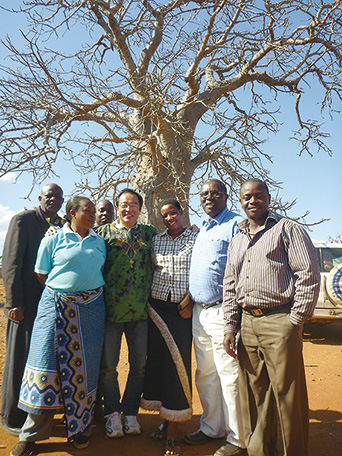
An expert, Mr. Michiyuki Shimoda and facilitators (instructors) in Mpwapwa District, Tanzania. (Photo: Michiyuki Shimoda)
Finally, Japan dispatched a policy advisor to the Prime Minister's Office, Regional Administration and Local Government (PMO-RALG) in order to give advice and guidance for overcoming challenges, while coordinating the four supports explained above. This expert explained to Tanzanian senior government officials and PMO-RALG executives about Japan's experience with building up a “Japanese-Western fusion” administrative system through trial and error while studying Western models. Thereby, the expert gave advice that was of help to the efforts of the Tanzanian people for establishing administrative systems based on their own ideas and discussions.
The first training project (in Tanzania, the project was given the congenial name of “Osaka Training” after the city of Osaka where the training facility was located) was also participated by local government directors at the region and district-levels. After learning about the history of Japan's administrative system, the trainees visited Japan's local cities and observed the situation of administrative services there and the government's relationship with residents. The trainees who participated in these trainings in Japan and then returned to their countries wished to share what they learned in Japan with their colleagues. The Tanzanian people organized seminars for sharing what they learned in Japan in all regions of Tanzania. Based on what they learned, various areas of Tanzania have begun making their own unique attempts. Furthermore, at the initiative of the participants of the Osaka Training, the “Tanzania Osaka Alumni” was established for local government directors from regions and districts throughout the country to gather together and report to each other about successful cases in their regions and to hold dialogues on the issues. With ODA backing, the Tanzanian people are harnessing Japan's experience for Tanzania's regional initiatives.
(2) Sustainable Economic Growth
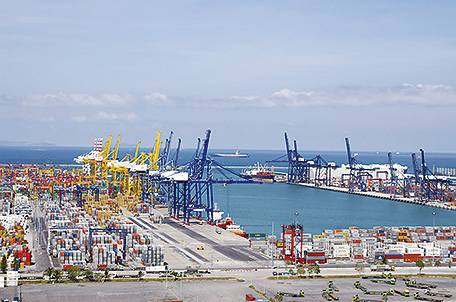
The Laem Chabang Port is the largest commercial port in Thailand. (Photo: Eastern Sea Leam Chabang Terminal Co., Ltd. (ESCO))
The second characteristic of Japan's ODA is its focus on sustainable economic growth. Based on the view that the fundamental resolution of the poverty issue requires economic development as a basis, Japan has attached importance to the realization of sustainable economic growth through infrastructure development and human resources development. Infrastructure development and human resources development through Japan's ODA, including ODA loans, have developed the investment environment, vitalized trade, and supported the growth of the private sector economy in developing countries. Such activities have expanded employment and income generation opportunities and have had a significant effect on poverty reduction. For example, through Japan's cooperation, Asia witnessed economic leaps and made considerable progress towards the resolution of poverty in the region. Japan's cooperation has contributed considerably also to Southeast Asia's recent dramatic development.
In Thailand, natural gas fields were discovered off the coast of the Gulf of Siam in the 1970s. This prompted the Thai government to turn the eastern seaboard (ESB) facing the Gulf of Siam, southeast of the capital city of Bangkok, into an industrialization hub and embarked on its development. Japan's ODA played a large role in the realization of this development. In 1981, then-Prime Minister Zenko Suzuki announced during his visit to Thailand that Japan stood ready to extend cooperation. Then, in rapid succession, Japan dispatched port construction experts and conducted development surveys, among other activities, through ODA. As a result, in the following year of 1982, Japan established 16 support projects and provided 27 ODA loans in total. In addition to financial assistance, Japan supported Thailand's establishment of plans and provided technical advice, and thereby, implemented comprehensive and detailed ODA. The development of this area was a colossal project entailing the development of the heavy chemical industry that made use of natural gas, the development of industry bases centered on export-oriented industries, and the development of such infrastructures as ports, roads, and railways. Among these projects, the construction of the Laem Chabang Port was very useful as it supplemented the Bangkok Port, which, at the time, had insufficient water depth and was nearing its limit for transporting container vessels that were growing in size. The Laem Chabang Port alone can handle maritime transport in the ESB.
The development of the ESB had a positive effect on poverty reduction. The advancement of development and industrialization was accompanied by the vitalization of local economies, and many new jobs were created. In addition, the development of the ESB led to improvements in public services (road network expansion and maintenance enhancement based on increases in road transport at ports and industrial bases) and social services (primary education and basic health care services), which were associated with local governments' industrialization efforts and population increases.
The ESB has developed into Thailand's second largest industrial district after the Bangkok metropolitan area. The ESB's GDP growth rate, private investment amount, and employment opportunities, among other figures, are significantly higher than Thailand's national average. The number of containers handled at the Laem Chabang Port surpassed Bangkok Port's in 1998 and was the highest in Thailand and ranked in the 23rd in the world in 2012. As a result of this development, the ESB has transformed into a major industrial district. Many Japanese companies, including automobile-related companies, have moved into this area. Today, the ESB exports products produced in Thailand to all over the world.
(3) Human Security
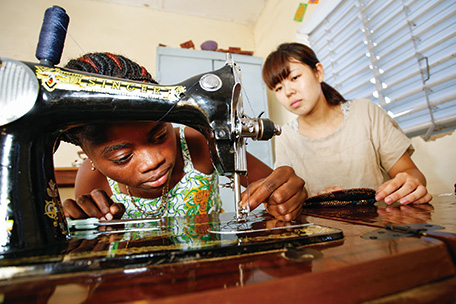
A Japan Overseas Cooperation Volunteer, Ms. Kana Iigatani, teaching sewing techniques to a deaf and dumb woman in a village near Ziniaré, Burkina Faso. Those women are working hard so that they can live independently by using the skills they learned. (Photo: Akio Iizuka / JICA)
The third characteristic of Japan's ODA is human security, which was explained in the previous section. As was touched upon briefly in the previous section, conflicts frequently broke out all over the world after the Cold War, and the world economy has become increasingly integrated due to the rapid advancement of globalization. Under such circumstances, the concept of human security has become ever more important as issues like poverty, environmental destruction, natural disasters, infectious diseases, terrorism, and sudden economic and financial crises cross national borders and become intertwined with each other, and at the same time, begin to have grave consequences on the lives and livelihoods of people across a large area. Human security provides a useful point of view in examining regional initiatives, such as TICAD, as well as responses to global issues, such as health, disaster risk reduction, and climate change, particularly, measures for people in vulnerable positions.
Assistance from the perspective of human security refers to protecting people in difficult circumstances from various threats, and through the empowerment of these individuals, helping promote nation-building and society-building. Specifically, Japan proactively extends ODA from this perspective in sectors such as education, health care, environment, gender, consolidation of peace, and nation-building. ODA of this type includes programs that build schools in developing countries, including in Africa, in order to enable as many children as possible to receive education, programs that make safe drinking water easily accessible to people in order to protect their lives and health, and programs that free children and women from the many hours of labor required for collecting water so that many children can attend schools and women can demonstrate their capabilities to the fullest.
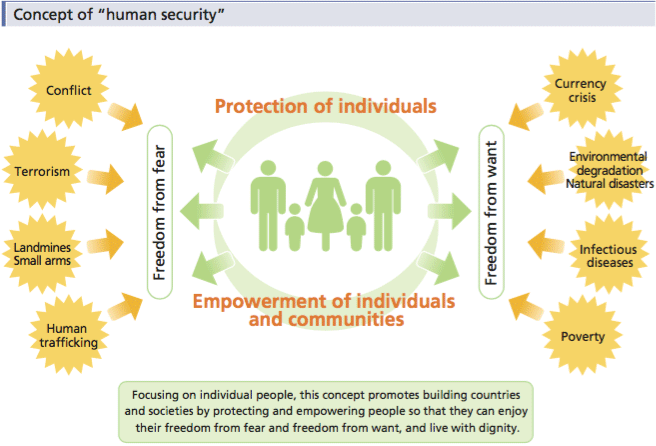
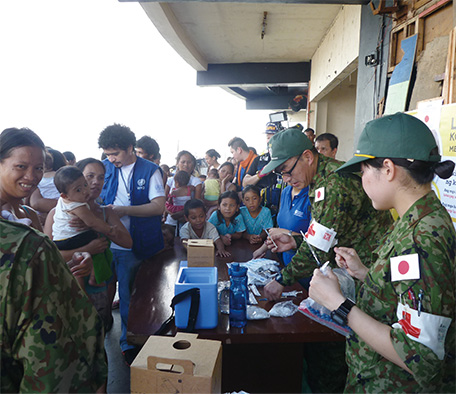
In November 2013, Japan Self-Defense Forces medical team as a Japan Disaster Relief (JDR) team provided medical treatment in the area affected by the typhoon (Yolanda) in the Philippines (Leyte Island.)
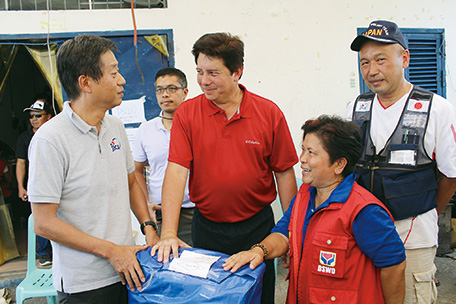
Tacloban City Mayor Alfred Romualdez and Department of Social Welfare and Development Secretary Dinky Soliman, receiving emergency aid goods from Japan in Tacloban where the disaster struck. (Photo: Tracy Decena / JICA Philippines Office)
Lusaka, the capital of Zambia in southern Africa, suffered a cholera outbreak in 1997. In response to this, Japan provided ODA that established public flushable toilets and showers in low-income residential areas where the cholera incidence rate was the highest. These facilities located in what were previously waste disposal sites came to be known among the local people as “KOSHU” (Japanese word for “public”). As a result of these activities, the number of cholera cases in this area decreased dramatically, and seven years later in 2004, there was only one case.
Humanitarian assistance and emergency relief aimed at rescuing and protecting people faced with imminent threats are another important effort in realizing human security.
In recent years, natural disasters, such as earthquakes and typhoons, have frequently occurred in various areas of the world, and they have been large-scale disasters of an unprecedented scale. In such times of humanitarian crises (crisis situations where humanitarian assistance is needed), including aftermath of the emergency situations and/or conflicts, Japan provides humanitarian assistance and emergency relief from the perspective of human security for saving lives and maintaining and protecting human dignity.
A recent example is Japan's emergency humanitarian assistance in response to the typhoon disaster that hit the Philippines in November 2013. In response to the catastrophic devastation caused by Typhoon Haiyan (Japanese name: Typhoon No. 30; Filipino name: Typhoon Yolanda) with over 7,000 deaths and missing people, Japan extended wide-ranging assistance through public-private partnerships in cooperation with the international community. Soon after the typhoon wreaked havoc, at the request of the Government of the Philippines, Japan Self-Defense Force Units comprised of a record approximately 1,100 personnel were deployed to the Philippines, in addition to the Medical Team and Expert Team, as part of the Japan Disaster Relief (JDR) Team. The team members provided supports that showed solidarity with the disaster affected people. A pregnant woman who was worried about the consequences of the disaster saw her healthy fetus using ultrasound imaging, and a smile returned to her face. Also, Japan made medical rounds to villages where assistance was hard to reach and strove to provide supports that reached beneficiaries at the grassroots level. In addition to the assistance provided by the JDR Team, Japan extended emergency grant aid of $30 million (approximately ¥3 billion) through international organizations, and provided emergency relief goods, such as tents, plastic sheets, and blankets. Furthermore, Japanese NGOs participating in Japan Platform (an NPO consisting of Japanese NGOs, the business community, and the government) distributed food and supplies, built shelters, and provided health and sanitation assistance as well as education assistance. Private companies also provided emergency assistance. In such ways, Japan extended a variety of assistances. The Government and the people of the Philippines as well as other international organizations operating in the affected areas expressed appreciation for Japan's assistance. The post about the dispatch of the JDR Team on the Facebook of Japan's Prime Minister's Office received over 70,000 “Likes” from all over the world.
2. Conclusion: Achievements and Evaluation of Japan's ODA
As the above examples demonstrate, Japan's ODA over a 60-year period did not just contribute to the development and growth of developing countries in various ways. ODA established firm bonds of friendship and trust between Japan and developing countries, and contributed significantly to improving Japan's standing in the international community, and by extension, to further ensuring peace and prosperity of Japan. There is no doubt that the cooperative efforts that Japan steadily built up through ODA helped establish deep trust and affinity towards Japan among the international community, including developing countries.
In this light, one of the achievements of Japan's ODA that marked its 60th anniversary is first and foremost its contribution to the economic development and welfare improvement of developing countries. Over the past 30 years, the circumstances of developing countries have improved dramatically. The number of people living on less than $1 a day has declined from 1.9 billion people to 1.2 billion people. As a percentage of the entire population, this is a decrease from 52% to 20%. The average life-span increased by seven years, and the infant mortality rate decreased by more than 45%. While this was an outcome of the efforts that developing countries themselves have made, there is no doubt that Japan's ODA played a significant part.
Additionally, the achievements of Japan's ODA had spillover effects on the supporting side, i.e., Japan. ASEAN, to which Japan has provided ODA with priority, has grown into a massive market with total GDP exceeding $2 trillion and receives attention as a world leading production hub. ASEAN is a vital market and investment destination for Japan. The fact that this region has achieved growth and stability has extreme significance for Japan's security, considering that the distribution network supporting the Japanese economy passes through this region.
Of course, Japan's ODA also had challenges and struggles. At times, frauds relating to ODA projects were practiced, or ODA projects did not deliver adequate aid effectiveness or encountered delays due to unforeseen circumstances. Sometimes ODA projects had unanticipated impacts on the environment or local communities, or resulted in accumulated debt. Occasionally Japan receives feedback that the visibility of Japanese aid is lacking, or that its objective has not been met. The Japanese government makes sure that none of these experiences were in vain, and to learn from them for the future. To this end, the government has remained committed to establishing evaluation schemes, increasing transparency, and holding dialogues with a wide range of stakeholders, including civil society. To see to it that Japan's ODA brings true prosperity to people in developing countries through effective and non-wasteful means, the government has established rigorous criteria in relation to environmental and social considerations, arrangements to prevent fraudulent practices, careful dialogues and coordination with recipient countries, and detailed project management and follow-up process. The government shall continue to engage in these efforts ceaselessly without ever becoming complacent in its achievements.
The people and the government of ODA recipient countries highly regard Japan's ODA. The countries appreciate the assistance they received from Japan during their challenging and difficult times. In addition, the sight of Japanese people jointly working hard in the field and the positive image of Japan that it shapes constitute the most important assets for Japan to continue to realize peace and prosperity in the international community. Some of these comments received from developing country governments and international organizations regarding their perceptions of Japan's ODA are presented below.
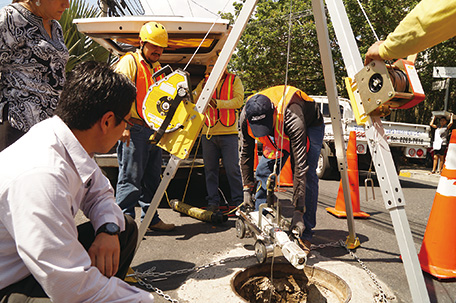
Under the Technique Assistance Project for the Department of Adaptation for the Climate Change and Strategic Risk Management for Strengthening of Public Infrastructure in El Salvador, officials from the Ministry of Public Works, Transportation, Housing and Urban Development, investigating drain pipes in San Salvador, the capital city of El Salvador. (Photo: Ernest Manzano / JICA)
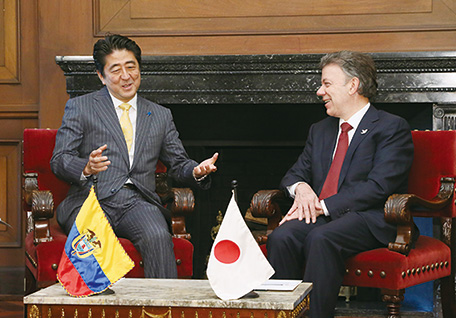
In July 2014, Prime Minister Shinzo Abe visited Columbia to attend the Japan-Colombia Summit Meeting, and was welcomed by President Juan Manuel Santos. (Photo: Cabinet Public Relations Office)
“(Japan's) engagement includes world-class expertise and world-renowned Japanese experts. Japan's leadership has provided the country with a high degree of visibility in all the five continents of the globe.” (Ms. Irina Bokova, Director-General of UNESCO, February 2012)
“Japanese cooperation has saved the lives of the Salvadoran people. According to a UN investigation of 6 years ago, El Salvador was ranked one of the most vulnerable countries in the world to natural disasters. However, thanks to the economic cooperation of Japan in the last 5 years, vulnerability has been reduced.” (Mr. Gerson Martínez, Minister of Public Works of El Salvador, June 2014)
“The Japanese are very good. There are upcountry projects where we had very weak local contactors but the Japanese would help them find solutions to any emerging problem.” (Mr. Abraham Byandala, Minister of Works and Transport of Uganda, January 2014)
“Japan's cooperation is not simply financial assistance. The cooperation is remarkable in the sense that it is human contributions. The Japanese people who are engaged in bilateral cooperation are very active, have a high sense of professionalism, and enjoy working in the field. Japanese young people are assigned to our country as Japan Overseas Cooperation Volunteers (JOCV), live with the people of Burkina Faso, and share their expertise. This is a very human cooperation, cooperation that is extended through people.” (Madame Koumba Boly/Barry, Ministre de l'Education Nationale et de l'Alphabétisation of Burkina Faso, July 2013)
In July 2014, Prime Minister Shinzo Abe visited Colombia and held a summit meeting with President Juan Manuel Santos. During the meeting, a video about local libraries that were constructed by Japan's ODA was shown. The video included a gratitude message for Prime Minister Abe from local children. Prime Minister Abe was then presented with a letter of gratitude from a girl who is making use of one of the libraries. In Colombia, due to the activities of illegitimate armed forces for many years, many children in the regions were not able to go to school even if they wanted to. Therefore, Japan focused its ODA activities on primary education and put efforts into establishing libraries for children. That Japan's ODA program reached the hearts of children in Colombia.
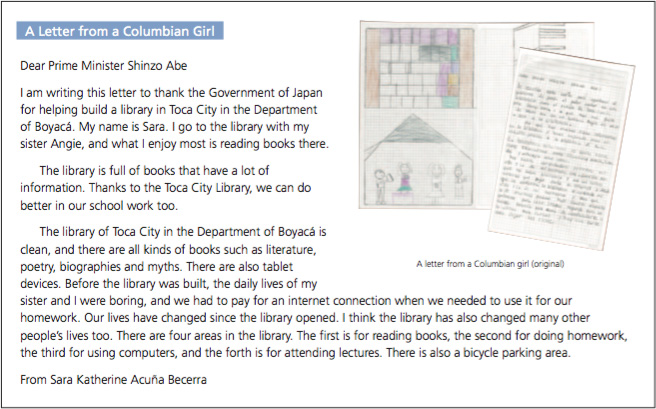
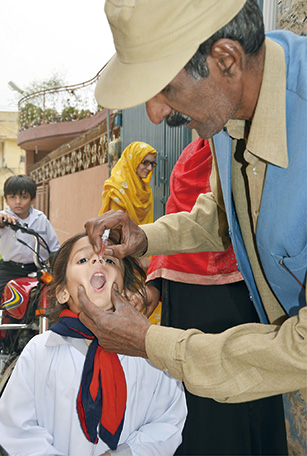
A child receiving polio vaccination in Rawalpindi, Pakistan in April 2014. Japan has been working with UNICEF to support efforts to eradicate polio in Pakistan since 1996. (Photo: Kyodo News)
Japan's ODA is appreciated also by international organizations. For instance, the OECD-DAC released the results of its Development Co-operation Peer Review for Japan(Note 10) in July 2014. In the report, the OECD-DAC appreciates Japan for: implementing development cooperation that contributes to human security, sustainable economic growth, and peace and stability guided by a clear vision; demonstrating leadership on assistance in sectors such as disaster risk reduction and health; and promoting inclusive development through partnering with the private sector and through triangular cooperation. In 2014, DAC established the DAC Prize for Taking Development Innovation to Scale in order to award innovative efforts which can be applied to a broad set of developing countries. Japan's ODA loan for Pakistan, the Polio Eradication Project, was selected as one of the outstanding projects for the First DAC Prize. The project was commended for its adoption of an innovative loan-conversion mechanism, in which if it is confirmed that the Government of Pakistan achieved a certain level of project outcomes, then the Bill & Melinda Gates Foundation assumes the ODA loan repayment on behalf of the Government of Pakistan. The achievement of the prescribed project outcomes was confirmed, and therefore, repayment by the Foundation was decided in April 2014.
In the aftermath of the Great East Japan Earthquake, 163 countries and regions from around the world, including many developing countries, as well as 43 international organizations offered their assistance to Japan. Disaster relief teams, medical support teams, and recovery teams from 24 countries and regions arrived in Japan. Many of the messages of solidarity that were sent to Japan at the time expressed appreciation for the ODA that they received from Japan when natural disasters struck their countries and for Japan's support of their development.
“Whenever the Philippines was struck by natural disaster, Japan was always the first to extend a helping hand. That is why the Philippines will help and will stand by Japan as much as possible” (Mr. Manuel M. Lopez, Ambassador of the Philippines to Japan).
As illustrated above, in no way have the people of the world forgotten about the assistance Japan extended through ODA.
- Note 9: An agency in a developing country that has received Japan's technical assistance in the past accepts training participants from other developing countries and offers technical guidance. Japan provides financial and technical cooperation.
- Note 10: In a Development Co-operation Peer Review of the OECD-DAC, DAC member states peer review other member states' development cooperation policies and their implementation statuses. The objective of the peer review is to recommend efforts for the implementation of more effective development cooperation through mutual learning on development cooperation experiences and approaches. The peer review of Japan was headed by France and Australia.
